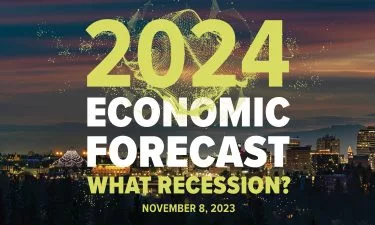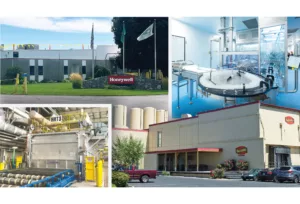Chance of recession becomes mild, but risks remain
Better than expected growth this year puts the region in better position for 2024

The good news as we exit 2023 is the U.S. avoided a widely expected recession this year. The bad news is the chance of a mild recession in 2024 still remains a risk.
Higher U.S. interest rates continue to put downward pressure on growth in the U.S. and Inland Northwest, and the Fed has signaled that rates may have to stay higher longer than markets expected a year ago.
Along with interest rates, significant political risks remain in play—in particular the wars in Ukraine and Israel and the resulting political tensions across the globe. Both wars have the potential to create energy price spikes and upset supply chains in a way that would put economic growth at risk and complicate the fight against inflation.
Adding to the international risks, the U.S. is confronting another tough election cycle that could negatively impact consumer and business confidence. The fall of former Speaker of the House Kevin McCarthy is a likely foreshadowing of the turmoil we could see within and between U.S. political parties in 2024. The traditional Democratic vs. Republican dichotomy continues to deteriorate with the fragmentation of U.S. politics.
Although risks abound, our region has had better than expected growth in 2023, which puts us in a stronger position as we move into 2024. Data through September indicates employment growth in the Spokane-Kootenai metro area will be around 2% in 2023. In comparison, the U.S. also had better-than-expected employment growth in 2023, with growth expected to be slightly higher than in the Inland Northwest.
This time last year, I had expected the U.S. and INW would enter and exit a historically mild recession in 2023. As a result, I forecasted regional employment growth would be near zero in 2023. Although the likelihood of a recession is still material, I think the possibility of a recession versus a soft-landing has improved from my 70% chance of a recession in 2023 to a 50% chance in 2024. With or without a recession, I expect employment growth will slip under 2% in 2024 as higher interest rates and political uncertainty slow the economy.
Even with 2023’s better-than-expected performance, long-term imbalances in the region’s economy remain. These include housing availability and affordability; labor shortages in key industries; and an aging population. In each of these cases, there are no quick, magic policy solutions to address these imbalances.
Turning first to housing, last year I cautioned not to expect a large correction in INW housing prices and rents like those seen following the Great Recession over a decade ago. I noted that on-going in-migration and a chronic low supply of homes for sale would work to offset the impact of higher interest rates. Housing market data confirms this expectation not just here, but in many markets across the U.S. (see graph). The tight supply and high cost of housing is complicating attempts to reduce chronic homelessness and move middle-class earners from renting to owning. As the Spokane region experienced this summer, wildfires also pose a significant risk to the supply of existing housing.
Next, the region is still confronting labor shortages in key industries, such as health care, the skilled trades, education, and transportation. Each of these sectors are major regional employers and provide crucial services. The demographic challenges confronting the region—that is, an aging population and surging retirements—are directly tied to these industries’ labor challenges.
For the health care sector this is a double hit: aging workers are leaving the sector at the same time an aging population will significantly increase the demand for health care. Given that U.S. households have an almost insatiable demand for health care, the health system will remain strained for the foreseeable future.
Finally, the region’s aging population reflects that most INW counties have zero or negative natural population growth—that is, each year deaths exceed or equal births. Unlike the past, this means population growth is no longer balanced between natural growth and in-migration. Without in-migration, the INW’s population growth would be zero or negative, and the region’s labor woes would be even more acute.
Our regional demographics are part of a larger global trend where most high- and middle-income countries, like the U.S. and China, have reached sub-replacement fertility rates. This means new generational groups (like Gen Z in the U.S.) will continue to decline in size compared to previous generations. In turn, this increases the importance of international immigration as a source of population and labor force growth.
Last year I noted the nation is suffering from crisis fatigue, reflecting constant turmoil since 9/11. Unfortunately, as demonstrated by the wars in Ukraine and Israel, U.S. political fragmentation, chronic homelessness, and wildfires, 2024 will continue provide little relief to our fatigue.
Dr. Grant Forsyth is the chief economist at Avista Corp. and previously was an economics professor at Eastern Washington University.
Related Articles
Related Products

_c.webp?t=1763626051)

_web.webp?t=1764835652)
